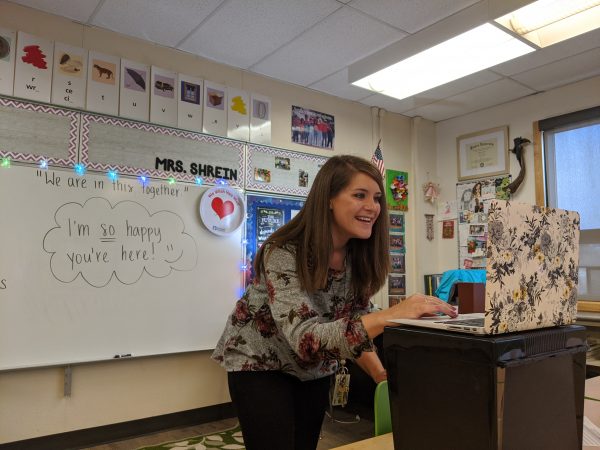
Between online learning and in-person classes, students throughout Alaska are back in school.
And with many families opting out of their regular schools, administrators are concerned about low enrollment and the reduced state funding that could follow.
It may be up to lawmakers to come up with a solution.
This school year is off to an unprecedented start, as the coronavirus pandemic continues to disrupt normal operations.
Whether students are back in the classroom depends on where they live and what individual families are comfortable with. And many aren’t yet sure what that means.
“Parents are just uncertain or unsure of how this school year will go. And they want some certainty,” said Shawn Arnold, Superintendent of the Valdez City School District. He says that uncertainty has convinced a number of parents to take their children out of schools. Many are turning to homeschool.
“We’ve lost about 20 plus students to other homeschool programs,” said Arnold. “And then we had about 60 students transfer from our classrooms into our homeschool program that we have here in Valdez.”
For a district of less than 1,000 students, those numbers are significant.
The amount of money a student’s home district gets from the state for correspondence students depends on which program they enroll in.
Financially, there is a lot at stake. State funding of public schools is tied directly to enrollment. Students are counted during a four-week period that begins at the end of September. Generally, more students means more funding. Factors like school size, cost-of-living, home schooling, and students with special needs also impact the amount of money districts receive.
Arnold is also president of the Alaska Superintendent’s Association. The organization sent a letter to the state Department of Education and Early Development, asking it to use student counts from 2019 to determine state aid for the coming fiscal year. The Alaska Association of School Boards is working on a similar proposal.
The letter from the Superintendent’s Association also asks the state to consider allowing some districts to use this year’s numbers, if their enrollment is higher than anticipated.
A number of things could cause that, including students enrolling in correspondence programs within the district or moving to smaller towns.
Heidi Teshner is the Director of School Finance with the state Department of Education. She says her department is paying close attention to challenges facing districts throughout the state. Right now, she says, they have to follow the funding formula as it is written in statute.
“The department has been looking and analyzing what kind of impacts there could be to districts,” said Teshner.
There’s a provision in state law that lets schools gradually absorb the financial impact of abrupt enrollment drops.
“…That could very well mean that districts don’t have as much of a decrease as they might be expecting,” said Teshner.
But, that funding is still reduced.
“It’s a three-year step-down approach,” said Teshner. “So 75%, 50%, 25%. … It’s not an immediate shock to the financials, it’s a step-down approach to the financials.”
Teshner says there’s one district that reached out to her for guidance that’s projected to get more money this year, despite seeing the declining enrollment trend. It has to do with the interplay of that provision, and how the formula scales per-pupil funding up and down at different sized schools. It’s meant to account for efficiencies at larger schools, and inefficiencies at smaller schools.
Teshner says any change to the funding formula would have to come from the legislature.
For Valdez, Arnold says students leaving schools could result in a loss of a couple hundred thousand dollars.
“Any movement within our own correspondence programs or to other programs in other districts and stuff, will sort of result in some sort of reduced funding,” said Arnold.
In a larger district, like Anchorage, there are millions of dollars on the line. The district currently has around 42,000 students enrolled. That’s down from just over 43,000 last year.
In Juneau, the district says enrollment numbers are down 10 percent, and hundreds of the remaining students are opting for home school.
When school districts finalized their budgets for this year, they didn’t know to factor in these kinds of drops in enrollment.
And then there are the really small districts, like Pelican. The Pelican City School District consists of one school and, this year, 12 students. The way the funding formula works, the district gets the same amount of money whether they have 10 students or 19, so their funding this year should remain steady. But Superintendent Norma Holmgaard says if enrollment fell below 10, she would have to worry.
“We only have five families coming into our building,” said Holmgaard. “So one family leaves and that is 20% of your population. At this point, we’re pretty sure that we’ll be over 10 for the count period, which is in October. Projecting for next year, I don’t know.”
Holmgaard says this is not just a pandemic problem for Pelican. It’s something she’s always worrying about.
“Every year, all the time,” said Holmgaard.
Lisa Parady, is head of the Alaska Council of School Administrators, an organization that represents school leaders in the state. She says there is still so much uncertainty, and varying needs throughout the state.
“We just need some support, and we need some grace, and we need all of us to work together to make sure that our students can continue with their learning in the best way possible,” said Parady.
Parady says these enrollment swings are expected to be temporary and if students do come back, districts will need the resources to support them.
Jeremy Hsieh contributed reporting from Juneau.




